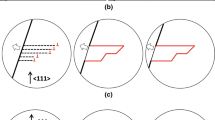Abstract
The effects of prior stored energy level, annealing temperature, heating velocity, and initial grain size on annealing twin development during static recrystallization of commercially pure nickel (99.999 %) are investigated. The twin content (measured as the twin boundary density or as the number of twins per grain) at the end of recrystallization is shown to be primarily influenced by the prior stored energy level and by the initial grain size, but the effects of heating rate and the annealing temperature are negligible. Taken together, the results are consistent with a new proposition that roughness of the recrystallization front promotes the formation of annealing twins during recrystallization.












Similar content being viewed by others
References
Wantanabe T (1984) Grain boundary design and control. Res Mech 11:47–84
Kumar M, King WE, Schwartz AJ (2000) Modifications to the microstructural topology in F.C.C. materials through thermomechanical processing. Acta Mater 48:2081–2091
Randle V (2004) Twinning-related grain boundary engineering. Acta Mater 52:4067–4081
Carpenter H, Tamura S (1926) The formation of twinned metallic crystals. Proc. R. Soc. 113:161
Gleiter H (1969) The formation of annealing twins. Acta Metall 17:1421–1428
Pande CS, Imam MA, Rath BB (1990) Study of annealing twins in FCC metals and alloys. Metall Trans A 21:2891–2896
Mahajan S, Pande CS, Imam MA, Rath BB (1997) Formation of annealing twins in F.C.C. crystals. Acta Mater 45:2633–2638
Song KH, Chun YB, Hwang SK (2007) Direct observation of annealing twin formation in a Pb-base alloy. Mater Sci Eng A 454–455:629–636
Thomson CB, Randle V (1990) A study of twinning in nickel. Scr Mater 35:385–390
Lee S-L, Richards NL (2005) The effect of single-step low strain and annealing of nickel on grain boundary character. Mater Sci Eng A 30:81–87
Cahoon JR, Li Q, Richards NL (2009) Microstructural and processing factors influencing the formation of annealing twins. Mater Sci Eng A 526:56–61
Jin Y, Lin B, Bernacki M, Rohrer GS, Rollett AD, Bozzolo N (2014) Annealing twin development during recrystallization and grain growth in pure Nickel. Mater Sci Eng A 597:295–303
Romero RJ, Murr LE (1995) Torque-related lamellar carbide growth associated with annealing twin in 304 stainless steel. Acta Metall Mater 43:461–469
Li B, Tin S (2014) The role of deformation temperature and strain on grain boundary engineering of Inconel 600. Mater Sci Eng A 603:104–113
Wang W, Brisset F, Helbert AL, Solas D, Drouelle I, Mathon MH, Baudin T (2014) Influence of stored energy on twin formation during primary recrystallization. Mater Sci Eng A 1(589):112–118
Bair JL, Hatch SL, Field DP (2014) Formation of annealing twin boundaries in nickel. Scr Mater 81:52–55
Chen XP, Li LF, Sun HF, Wang LX, Liu Q (2015) Studies on the evolution of annealing twins during recrystallization and grain growth in highly rolled pure nickel. Mater Sci Eng A 622:108–113
Li Z, Zhang L, Sun N, Sun Y, Shan A (2014) Effects of prior deformation and annealing process on microstructure and annealing twin density in a nickel based alloy. Mater Charact 95:299–306
Randle V (2002) Sigma-boundary statistics by length and number. Interface Sci 10:271–277
Kumar M, King WE (2005) Universal features of grain boundary networks in FCC materials. J Mater Sci 40:847–852. doi:10.1007/s10853-005-6500-9
Alvi MH, Cheong SW, Suni JP, Weiland H, Rollett AD (2008) Cube texture in hot-rolled aluminum alloy 1050 (AA1050)—nucleation and growth behavior. Acta Mater 56:3098–3108
Brandon DG (1969) The structure of high-angle grain boundaries. Acta Metall 14:1479–1484
Wang W, Lartigue-Korinek S, Brisset F, Helbert AL, Bourgon J, Baudin T (2015) Formation of annealing twins during primary recrystallization of two low stacking fault energy Ni-based alloys. J Mater Sci 50:2167–2177. doi:10.1007/s10853-014-8780-4
Wang S, Holm EA, Suni J, Alvi MH, Kalu PN, Rollett AD (2011) Modeling the recrystallized grain size in single phase materials. Acta Mater 59:3872–3882
Maksimova EL, Robkin EI, Shvindleman LS, Straumal BB (1989) Phase transitions at grain boundaries in the presence of impurities. Acta Metal 37:1995–1998
Zhang H, Srolovitz DJ (2006) Characterization of atomic motion governing grain boundary migration. Phys Rev B 74:115404
Yan X, Zhang H (2010) On the atomistic mechanisms of grain boundary migration in [001] twist boundaries: molecular dynamics simulations. Comput Mater Sci 48:773–782
Zhang H, Srolovitz DJ, Douglas JF, Warren JA (2009) Grain boundaries exhibit the dynamics of glass-forming liquids. PNAS 106:7735–7740
Humphreys FJ (2004) Recrystallization and related annealing phenomena. M. Hatherly, Elsevier, Amsterdam
Epstein N (1989) On tortuosity and the tortuosity factor in flow and diffusion through porous media. Chem Eng Sci 44:777–779
Martorano MA, Fortes MA, Padilha AF (2006) The growth of protrusion at the boundary of a recrystallized grain. Acta Mater 54:2769–2776
Kumar M, Schwartz AJ, King WE (2002) Microstructural evolution during grain boundary engineering of low to medium stacking fault energy fcc materials. Acta Mater 50:2599–2612
Acknowledgements
This work was funded by the French National Research Agency (ANR project called FORMATING: ANR-11-NS09-001-01) and the Materials World Network of the US National Science Foundation under grant number DMR-1107986.
Author information
Authors and Affiliations
Corresponding author
Rights and permissions
About this article
Cite this article
Jin, Y., Lin, B., Rollett, A.D. et al. Thermo-mechanical factors influencing annealing twin development in nickel during recrystallization. J Mater Sci 50, 5191–5203 (2015). https://doi.org/10.1007/s10853-015-9067-0
Received:
Accepted:
Published:
Issue Date:
DOI: https://doi.org/10.1007/s10853-015-9067-0




